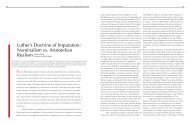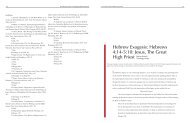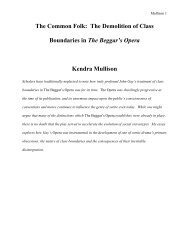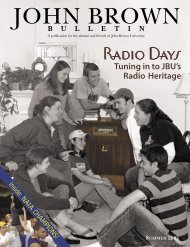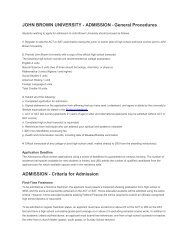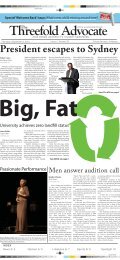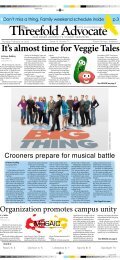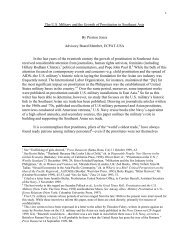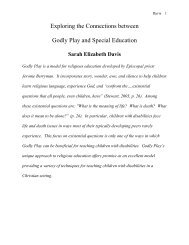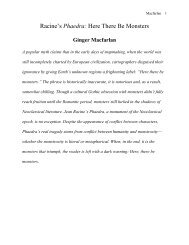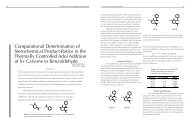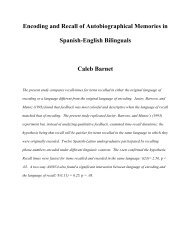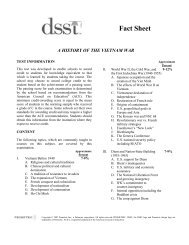Download entire journal document - John Brown University
Download entire journal document - John Brown University
Download entire journal document - John Brown University
You also want an ePaper? Increase the reach of your titles
YUMPU automatically turns print PDFs into web optimized ePapers that Google loves.
Editorial Board<br />
Editor-in-Chief<br />
Joseph Buck<br />
Editors<br />
Katelin Duffie<br />
Jacob Little<br />
Manuel Garcia<br />
Adam Mackall<br />
Bethany Kerstetter<br />
Kendra Mullison<br />
Allison Kunkel<br />
Faculty Advisor<br />
Rick Froman<br />
Journal Design<br />
Benjamin Martin<br />
Cover Art<br />
<strong>John</strong> Sebesta
Table of Contents<br />
1<br />
2<br />
3<br />
4<br />
Introduction<br />
Acknowledgements<br />
Faculty Note<br />
Projects<br />
4<br />
5<br />
5<br />
9<br />
Division of Biblical Studies<br />
Division of Business<br />
Division of Communication and Fine Arts<br />
Division of Humanities and Social Sciences
Introduction<br />
I hope that you enjoy reading this first volume of <strong>John</strong> <strong>Brown</strong> <strong>University</strong>’s new<br />
undergraduate, student-run <strong>journal</strong>: Broaden. Since this is the first year that Broaden is being<br />
published, the other editors and I had a lot of things to figure out along the way. Our first task as<br />
editors was to figure out how to raise awareness of a new <strong>journal</strong> that no one knew anything about.<br />
We talked to students and let them know what the <strong>journal</strong> is, and we urged faculty members to<br />
encourage the submission of top projects and papers. Submissions were divided by subject area, and<br />
the team of editors, representing many majors, evaluated submissions from fields with which they<br />
were most familiar. This represented the first round of evaluation. After the first editors finished<br />
with a list of possible publications, those submissions were evaluated again by different editors,<br />
often editors representing different disciplines. After approval from a first and a second editor, each<br />
published submission was then checked with a professor in the field. Our editors then asked the<br />
submitters to make any changes necessary in their projects before final publication.<br />
I hope that this <strong>journal</strong> will encourage future research and academic pursuit, and I am<br />
looking forward to even greater quality next year. The projects that are published this year should<br />
serve as an example of the kind of work that faculty want to encourage at JBU, the kind of work<br />
that JBU students are capable of. Broaden also gives JBU students an opportunity to share their best<br />
work with the world.<br />
All of the projects published in this first volume are worthy of congratulation, but three of<br />
those projects won our prizes as the top three academic projects submitted this year. Our three prize<br />
winners, each taking home $50, are Brandon Hix, Lindsey Zachary, and the business team Enterra,<br />
consisting of Marcus Naramore, Yaribeth Pacheco, Maria Jose Valencia, <strong>John</strong> Williams, and<br />
Micah Williams. In the main section of this <strong>document</strong>, readers will find abstracts for all the<br />
published projects, as well as titles, names of authors, and names of faculty sponsors. The abstracts<br />
are sorted by division, then alphabetically by authors’ last names.<br />
Joseph Buck, 2008 Editor-in-Chief<br />
1
Acknowledgements<br />
The following faculty members contributed to the evaluation process, giving valuable insight<br />
to the editors: Holly Allen, Dave Andrus, Jim Blankenship, Rick Froman, Gary Guinn, Jonathan<br />
Himes, Mandy Moore, Frank Niles, Nick Ogle, Bonnie Osmon, Trisha Posey, and Warren Roby.<br />
The editors would like to extend their appreciation to these faculty members.<br />
The editors would also like to thank all of JBU’s faculty for being supportive and willing<br />
to help by nominating projects and helping to evaluate them. Rick Froman deserves appreciation<br />
for his valuable insights in guiding this first volume of Broaden. He let the students make most of<br />
the decisions, since this is a student-run <strong>journal</strong>, but he was always there for advice and help when<br />
needed. Brad Gambill, as the Honors Director, helped get the <strong>journal</strong> going in the early stages. He<br />
provided some helpful ideas, and he was the one who hired me to start the process. Also, we would<br />
like to thank Hannah Toldt for providing the title of the <strong>journal</strong>.<br />
2
Faculty Note<br />
The publication of the inaugural volume of Broaden: The <strong>John</strong> <strong>Brown</strong> <strong>University</strong><br />
Undergraduate Journal marks a new opportunity for students at <strong>John</strong> <strong>Brown</strong> <strong>University</strong> to<br />
disseminate their original work. It was designed to be accessible to JBU students in all majors from<br />
Accounting to Youth Ministries (JBU really needs to consider starting a Zoology major to be truly<br />
comprehensive). It is also expected to bridge the gap between traditional undergraduates and adult<br />
completion students in providing recognition of high quality work.<br />
This <strong>journal</strong> has been designed with a number of purposes in mind. First, it is designed to<br />
encourage the highest level of student scholarship at JBU by rewarding excellence in scholarship<br />
with publication. Second, it is designed to strengthen the culture of scholarship at JBU by<br />
providing a publication outlet to demonstrate excellence in scholarship to both internal and<br />
external audiences. Third, it is designed to provide the student editorial board with an<br />
opportunity to have real life experience in the peer review process that characterizes the<br />
publication process of an academic <strong>journal</strong>.<br />
While the achievement of the first two purposes awaits the impact the <strong>journal</strong> will have on<br />
the campus in future years, the third one has already been achieved by this year’s student editorial<br />
staff, led by student editor Joseph Buck. Joseph has not only organized the editorial staff and<br />
managed the <strong>entire</strong> process, he had to create the process almost ex nihilo (of course, he had more<br />
to build on than the original Creator). I also appreciate the vision he has for the future of the<br />
<strong>journal</strong> and for providing future student editors with standardized policies and procedures to make<br />
their lives easier. The student editors carefully read many submissions and made decisions about<br />
publication. The high level of quality achieved by the <strong>journal</strong> in this first year is due almost <strong>entire</strong>ly<br />
to the hard work of the editor and the student editorial board. I expect that future editors and<br />
editorial boards will be able to continue to build an excellent <strong>journal</strong> on the foundation laid this year.<br />
I would also like to thank the following for their important roles in founding this <strong>journal</strong>:<br />
• Brad Gambill for providing financial support for the prizes and a home for the <strong>journal</strong> in the<br />
Honors Scholars Program.<br />
• Rick Ostrander and Galen <strong>John</strong>son for their encouragement and support in initiating the project.<br />
• Andrea Phillips, Mark Stoner, and Benjamin Martin for their encouragement and excitement<br />
about the project and their hard work in making the website a reality.<br />
• The JBU faculty who supported the project by nominating students editors from their<br />
disciplines, encouraging students to submit their work, and sponsoring the projects<br />
3<br />
that were published.<br />
Thank you all for bringing this dream to reality.<br />
Dr. Rick Froman, Faculty Advisor
Projects<br />
Division of Biblical Studies<br />
Christa Adams<br />
Sponsor: Holly Allen<br />
Nehemiah: The Good Hand of God (Click to open in web page)<br />
This is a children’s curriculum designed to teach the book of Nehemiah to children in grades 3-5.<br />
The purpose of this material is to teach children about what God did in the life of Nehemiah. The<br />
ideal outcome of all children’s curricula is that children will adopt the concepts and practices<br />
presented into their own lives. This material is a guideline to be used by teachers in preparation<br />
for a lesson, but accommodations should always be made according to the size and behavior of<br />
the group to which the material is being taught. The goal of this curriculum is to present the<br />
holistic, biblical material in an accurate, appealing, and age-appropriate manner.<br />
Jason Korner<br />
Sponsor: Jim Blankenship<br />
Developments in Ancient Israelite Religion as a Tool for Dating Hebrew Bible Authorship (Click to<br />
open in web page)<br />
This paper attempts to date the origins of authorship for parts of the Hebrew Bible. By<br />
examining parallels between the Canaanite god El and the Hebrew god of Yahweh, I argue that<br />
the patriarchal narratives have origins in the mid-second millennium B.C.E. In observing the<br />
Israelite condemnation of Baal worship during the divided monarchy, I argue in favor of dating<br />
the original authorship of Exodus before the ninth century B.C.E. due to the book’s lack of Baal<br />
condemnation. In addition to this, the changing role of Yahweh in the divine council as seen<br />
throughout the Hebrew Bible leads to the conclusion that Israel’s understanding of Yahweh changed<br />
over time. Therefore, the origins of certain Hebrew Scriptures can be dated according to the role<br />
of Yahweh in the divine council.<br />
Melissa Zabka<br />
Sponsor: Nick Ogle<br />
Capping Pharmaceuticals: Financial Limitations (Click to open in web page)<br />
Currently pharmaceutical companies are charging over 200% more for the products they sell<br />
than what they are paying to produce the same product. This turns the identity of a company that<br />
is allegedly aiming to save and heal people into a business corporation banking on illness. I am<br />
proposing a new law that sets a financial profit standard where the drug company can only charge<br />
75% more than what it costs them to produce the drug. This will make drugs more affordable<br />
and health care so that poorer people may have a chance at affording the means needed<br />
to live.<br />
4
Division of Business<br />
Marcus Naramore, Yaribeth Pacheco, Maria Jose Valencia, <strong>John</strong> Williams, and Micah<br />
Williams - Prize Winner<br />
Sponsor: Mandy Moore<br />
Enterra: Style from the Ground up (Click to open in web page)<br />
Enterra is a provider of sustainable apparel, accessories, shoes, and home goods to conscientious<br />
consumers in Northwest Arkansas. Enterra is a retail store located in Fayetteville Arkansas that<br />
sells environmentally sustainable, stylish products. With its smart mix of products from leading<br />
sustainable fashion companies such as TOMS shoes and Loomstate, Enterra will make sustainable<br />
fashion accessible to consumers who want to be environmentally friendly but are not yet acquainted<br />
with stylish sustainable clothing. Not only does Enterra sell sustainable products, but it is a holistically<br />
environmentally friendly business, using recycled displays, bamboo flooring, energy efficient utilities,<br />
and waste-saving reusable shopping bags. With its strategic location in Fayetteville Arkansas, which is<br />
renowned as a “green” hotspot, Enterra will yield a positive net income in year one of operation, and<br />
sustain a 12% growth in sales in each of the first five years. Through its physical location enabling<br />
consumers to touch and feel the products, its unique product line, and its passionate and knowledgeable<br />
sales team, Enterra will be profitable not only financially, but environmentally and socially as well.<br />
Division of Communication and Fine Arts<br />
Emily Caneday<br />
Sponsor: Dave Andrus<br />
A Social Awareness Poster (Click to open in web page)<br />
This is a social-awareness poster. The assignment was to promote a view on a logging<br />
environmental issue using typography and imagery. Using Adobe Illustrator, I created this poster<br />
(22” x 28”) explaining how logging kills and endangers salmon. I used the idea of a game to<br />
draw the viewer in. The poster asks the question “How many fish can you find?” Typography<br />
comes into play with this question. The “f”s are actually question marks flipped and “any” stands<br />
out in a different color to reiterate the question. The viewer begins looking through the logs for<br />
fish and cannot find any. Confused, the viewer looks below to the paragraph, discovers there are<br />
zero fish, and then reads the explanation.<br />
Song Lyrics (Click to open in web page)<br />
This open-ended typography assignment asked us to set the lyrics of a song in a creative way.<br />
Using the lyrics of Barlowgirl’s acoustic track “Never Alone,” I created in Adobe Illustrator this<br />
vector image. I created it at 12” x 9”, but it could be printed at any size. The overall feeling of<br />
this acoustic song is loneliness. In the end, the singer recognizes that God is always there for her,<br />
but she must first work through some of her thoughts. I decided that standing alone in the rain<br />
was the epitome of loneliness, so I created a vector image of a young woman with an umbrella.<br />
The lyrics of the song became a sad rainfall.<br />
5
Ben Congdon<br />
Sponsor: Dave Andrus<br />
Kangaroos (Click to open in web page)<br />
This assignment involved using India ink pens to create an illustration based on a photograph. I<br />
chose a photo my family had taken while we were living in Australia. In this project, more than<br />
any other I have done, I became so caught up with capturing the detail from the photograph that I<br />
worked well beyond the due date of the project. In the end, this 8 by 10 inch piece took over 4<br />
months of work to complete.<br />
Resolve (Click to open in web page)<br />
This is a charcoal drawing I did during my freshman year at JBU. The project was to experiment<br />
with foreshortening, a process where you intentionally distort the size of the foreground and<br />
background. In so doing, you make the viewer feel right there next to the action. The idea for<br />
using a World War II setting actually came after I had drawn the hand and the knife. The original<br />
size of this illustration is 12 by 18 inches.<br />
Jesse DeFriese<br />
Sponsor: Dave Andrus<br />
Teacup (Click to open in web page)<br />
This is a 33” x 47” painting from my two weeks at Oklahoma Summer Arts Institute 2007 under<br />
the instruction of Robert Zakanitch, a renowned painter. The assignment was to enlarge a teacup<br />
still life in acrylic paint. It was challenging to learn to see color: white is never white, but rather a<br />
blend of infinite tertiary colors. We also studied the effect that mixing black and white has with<br />
the six colors on the basic color-wheel. I learned how many colors contribute to creating gold—<br />
most important being black. Because the work was so large, it took more than one day to<br />
complete, and the light coming through the windows changed the reflections and highlights as<br />
the sun ran its course throughout the day.<br />
Justin Eddy<br />
Sponsor: Dave Andrus<br />
Corp ID (Click to open in web page)<br />
This identity system was designed for a company called Igloo Cocoa & Company. They specialize<br />
in hot drinks, specifically hot chocolate. Naturally, hot chocolate is the tastiest wherever the weather<br />
is the coldest, so the company is based in the middle of the frozen arctic. This idea is reinforced by<br />
the cool color palette, along with the igloo and polar bears. The Courier typeface helps reinforce the<br />
feeling of remoteness, which a company in the middle of the arctic probably has. At the same time,<br />
because people usually associate hot chocolate with curling up in front of the fireplace with a favorite<br />
book and under a favorite blanket, I wanted the look to feel comfortable.<br />
6
Rebuilding the Soul of Design (Click to open in web page)<br />
The assignment asked me to create a magazine spread for the magazine Christianity Today. The<br />
professor had me write an essay response to a chapter out of Daniel Kantor’s novel, Graphic<br />
Design & Religion, for which I was required to use original writing for the text in my magazine<br />
spread. The spread design had to reinforce the content of the article, which happened to cover the<br />
need for renewal in the relationship between the arts and the Church. So my concept was to make<br />
the spread itself feel like a construction blueprint, as if one was rebuilding the subject matter.<br />
The file was constructed in InDesign, and the imagery and text are completely original.<br />
Brandon Hix - Prize Winner<br />
Sponsor: Dave Andrus<br />
Honda Civic (Click to open in web page)<br />
I created this piece for a final project in my 3D Advanced class. The <strong>entire</strong> piece was created<br />
using Maya 8. I started with simple blueprints of a 2006 Honda Civic which I loaded into Maya.<br />
I then proceeded to sculpt the overall shape of the car from a single cube. After finishing the high<br />
resolution geometry for the car, I began to research methods which could be used to create the<br />
material for the car paint. This was the most difficult part of the process. About two weeks were<br />
spent mixing and matching colors and different reflection algorithms to get the finalized paint.<br />
From start to finish, I spent a total of about 40 hours on the project.<br />
Jamie Raymer<br />
Sponsor: Dave Andrus<br />
Children (Click to open in web page)<br />
I shot this photograph in Kenya, Africa using a Casio Exilim EX-S500 camera. I was on a<br />
missions trip during the summer of 2006. It was early afternoon, and I was visiting an orphanage<br />
for the day. In this picture, the children were lined up waiting to receive the clothing, shoes, and<br />
toys we had brought for them. It was an amazing experience to be able to interact with the<br />
children that many times are the very ones who are forgotten. They were such beautiful, happy<br />
children. I learned much in the little amount of time I got to spend with them. I hope these<br />
children are never forgotten.<br />
<strong>John</strong> Sebesta<br />
Sponsor: Dave Andrus<br />
Unexpected Beauty (Click to open in web page)<br />
This shot was taken around noon at San Gabriel Park in Georgetown, TX, on August 26, 2007. It<br />
was a slightly overcast day, contributing to the rich colors. I used my old but trusty Canon<br />
SD200. The shot was meant to show beauty in unexpected places. There are many things people<br />
pass over and I wanted this shot to show some of the beauty that can be found, even near a<br />
drainage pipe. I am also fascinated with the union of nature and humanity: the leaves as purely<br />
nature; the pipe as purely human; and the rock wall as humanity’s manipulation of nature.<br />
7
Jameson Sheppard<br />
Sponsor: Dave Andrus<br />
Burton Ad (Click to open in web page)<br />
The goal of this graphic design project, designed for Digital Darkroom, was to make a magazine<br />
advertisement (10’’ x 8’’) geared toward young women for Burton Snowboards. I used a royalty<br />
free image from www.sxc.hu (by Jaanus E. called ‘Big Air’) which composed the original portion<br />
of the image. With color correction, a textured brush and some contrast effects, I changed the<br />
look of the photo and added the purple, flowing dots and the clouds in the background. I also<br />
added the trees and snowboarder reflection in her goggles. I wanted to give Burton a completely<br />
new, fresh feel—one that you could almost taste and smell.<br />
Natalie Slater<br />
Sponsor: Dave Andrus<br />
Colors of the Night (Click to open in web page)<br />
The photos included are from a gallery show entitled Colors of the Night which is a night<br />
photography exhibit designed to illuminate the colors of small towns in the late hours of night.<br />
These long exposure photographs, preserved as digital prints on metallic paper, have depth and<br />
streaks of color that the human eye cannot perceive on its own. The surreal quality of these<br />
images is intriguing in both color and concept. Colors of the Night captures the beauty of the<br />
common night, be it foggy, cloudy, clear, or starry, revealing the night’s true colors to those who<br />
may never have stopped to look.<br />
Traditionally: Catholicism in Málaga, Spain (Click to open in web page)<br />
The photos included here are part of a book entitled Traditionally: Catholicism in Málaga, Spain,<br />
which is a study on how Catholic traditions are fully ingrained into the people of Málaga.<br />
Walking around the city, it was hard to miss how this belief system affects their every day lives.<br />
My hope with this collection was to visually communicate the vast, intricate details in the<br />
Catholic traditions. The series starts by showing how tall the cathedrals are on the outside, and it<br />
ends by showing the magnificent and impressive interiors of these gorgeous cathedrals. The<br />
images in this book were pulled together in a trip that encompassed five weeks. The camera of<br />
choice was a Nikon D200, and most of these images were not heavily edited (simple color<br />
corrections and cropping).<br />
Matthew Smith<br />
Sponsor: Dave Andrus<br />
My family has always loved traveling. This past summer my father and I decided to go visit<br />
some relatives who were on a sabbatical in Salzburg, Austria. As a photography major, I brought<br />
along my camera and took many photographs while we traveled and camped in Austria,<br />
Germany, Switzerland, and France. (Continued on next page)<br />
8
Gollinger Fall (Click to open in web page)<br />
1/60 sec at f / 3.5<br />
ISO 200<br />
Gollinger Fall<br />
Golling, Austria<br />
July 27, 2007 - 4:59PM<br />
Pentax K100D<br />
Neuschwanstein (Click to open in web page)<br />
1/1500 sec at f / 4.5<br />
ISO 200<br />
Neuschwanstein<br />
Near Munich, Germany<br />
July 31, 2007 - 2:34PM<br />
Pentax K100D<br />
Hallstattsee Nord (Click to open in web page)<br />
1/180 sec at f / 9.5<br />
ISO 200<br />
Hallstattsee Nord<br />
Hallstatt, Austria<br />
August 6, 2007 - 12:52PM<br />
Pentax K100D<br />
Division of Humanities and Social Sciences<br />
Caleb Barnet<br />
Sponsor: Trisha Posey<br />
The Spread and Appeal of Arianism (Click to open in web page)<br />
Arianism, an early fourth-century Trinitarian heresy that affirmed the Son Jesus Christ’s<br />
subordination to the Father, embodied, in many ways, the archetypal heterodoxy. It emerged at a<br />
rather unfortunate time in Christian history and precipitated substantial upheaval in its day.<br />
Nevertheless, Arianism, unlike most similar heresies, actually constituted the Christian orthodox<br />
belief at one time (A.D. 326-381). This paper will therefore address the period after the heresy’s<br />
official denunciation at Nicaea in 325—a period distinctively marked by its prominence in<br />
political spheres and among a substantial percentage of believers—and the principal factors that<br />
made such an ascension to power possible.<br />
9
Katelin Duffie<br />
Sponsor: Warren Roby<br />
The Role of Phonemic and Phonological Awareness in the Early Childhood Classroom (Click to<br />
open in web page)<br />
This paper defines phonemic and phonological awareness as they relate to reading instruction in<br />
the early childhood classroom. It focuses on why developing phonemic and phonological<br />
awareness is crucial for students as they begin to learn how to read as well as providing<br />
strategies for helping students develop these competencies. The paper emphasizes the importance<br />
of knowing the level of each student’s development of phonemic and phonological awareness so<br />
that instruction can be differentiated in such a way that each student is receiving the type of<br />
instruction that will be most beneficial to him or her.<br />
Nicole Ediger<br />
Sponsor: Frank Niles<br />
The Right Time to Go Left: Evangelicals and Religious Interest Groups (Click to open in web page)<br />
Evangelicalism is marked by authoritative biblical interpretation, which has driven both the<br />
Evangelical Left and Right to have strong, fundamentalist stances in their approach to<br />
government. As interest groups, both employ similar strategies of being prophetic outsiders that<br />
seek fundamental change. Their content differs, with the Evangelical Left focusing on social<br />
justice and economic issues while the Right is concerned about America’s morals. The Right also<br />
is more candidate-centered. Thus far, the voice of the Right has overshadowed the efforts of the<br />
Left, but conditions in the political climate and an opportunistic strategy of activism for Darfur<br />
could pull evangelicals toward more liberal ideology.<br />
Katherine Grimes<br />
Sponsor: Rick Froman<br />
Coming to College: Correlations between Loneliness, Homesickness and Spiritual Well-Being<br />
(Click to open in web page)<br />
Previous research shows that there is a negative relationship between loneliness and faith, and a<br />
positive relationship between loneliness and homesickness. However, research does not show if<br />
there is a connection between homesickness and faith. Thirty-nine college freshmen at <strong>John</strong><br />
<strong>Brown</strong> <strong>University</strong> took a survey examining these variables. Pearson-R correlations were done to<br />
examine the relationships between the three variables. Results show a significant positive<br />
correlation between homesickness and loneliness, but no significant correlations involving<br />
spiritual well-being. Discussion includes reasoning for the connection between loneliness and<br />
homesickness, and examines reasons why no correlation was found in regards to spirituality.<br />
10
Rachel Lapo<br />
Sponsor: Warren Roby<br />
Facilitation of Positive Transfer from Spanish to English: Analysis of Similarities and<br />
Differences in Regards to Semantics, Syntax, and Phonology (Click to open in web page)<br />
In consideration of the vast variance in syntax, semantics, and phonology among languages,<br />
learning a second language may seem daunting or even impossible at times. Although learning<br />
English is a challenging task for many Spanish speakers, positive transfer can simplify the<br />
process of acquisition. Regardless of the prevalence of similarities or differences between two<br />
languages, a person’s knowledge of their native language directly impacts their acquisition of a<br />
second language. Knowledge of the similarities and differences between Spanish and English is<br />
crucial in regards to establishing connections between the languages and in facilitating positive<br />
transfer from Spanish to English.<br />
Jacob Little<br />
Sponsor: Trisha Posey<br />
The Fall of the Roman Empire (Click to open in web page)<br />
The causes and effects of the fall of the Roman Empire have fueled much scholarly and political<br />
debate for centuries. In this paper, I examine the claims of St. Augustine, Bishop of Hippo and a<br />
contemporary of the sacking of Rome in 410 C.E, and Edward Gibbon, an 18th-century historian<br />
and author of The History of the Decline and Fall of the Roman Empire, and seek to find a<br />
synthesis of cause and effect between the two. Gibbon claims that Christians were largely at fault<br />
for the fall of the Empire while Augustine seeks to lift blame from Christians. The sources come<br />
from very different contexts, but both provide insight on a topic that has implications for the present.<br />
Matthew Nye<br />
Sponsor: Trisha Posey<br />
The Influence of Classical Ideas on Thomas Jefferson through an Examination of His View on<br />
Roman Law (Click to open in web page)<br />
At its broadest, this essay examines the effects of classical influences on early American history.<br />
More specifically, it looks at Thomas Jefferson’s opinion and possible use of Roman law. I will<br />
attempt to establish that Thomas Jefferson deemed that Roman law had contemporary legitimacy<br />
and that it had more than indirect influence (through its evolution through European legal<br />
systems) upon American legal issues. This issue is important because it elucidates one aspect of<br />
the tension that exists between civil vs. common law in American legal debates. It also provides<br />
a way to gauge whether classical ideas, which were often cited during the Revolutionary period,<br />
were truly influential upon early America or merely given lip service in order to provide a sense<br />
of legitimacy to Revolutionary ideas.<br />
11
Lindsey Zachary - Prize Winner<br />
Sponsor: Gary Guinn<br />
Formalist and Archetypal Interpretations of The Cat in the Hat (Click to open in web page)<br />
It might seem as if the scholarly realm of literary theory could have nothing to do with a<br />
children’s book such as The Cat in the Hat. However, by applying formalist criticism to Dr.<br />
Seuss’s story, the reader can see how elements of punctuation, meter, rhyme, and repetition work<br />
together to create a sense of constant action and spontaneity, paralleling the events of the story<br />
and the unpredictable character of the Cat himself. Secondly, when Seuss’s story is viewed<br />
through the lens of archetypal criticism, it becomes clear that The Cat in the Hat is not just a<br />
simple tale for children. Rather, it is a story which presents the playful Cat’s revolt against<br />
authority and subversion of traditional societal values and subtly affirms that insurrection.<br />
12



